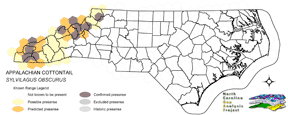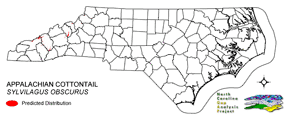
| Taxa: |
| Order: |
| Family: |
| Mammalia |
| Lagomorpha |
| Leporidae |
| NatureServe Global Rank: |
| NatureServe State (NC) Rank: |
| G4 |
| S3 |
| Federal Status: |
| NC State Status: |
| FSC |
| SR |


| Land Unit |
| US Fish & Wildlife Service |
| US Forest Service |
| US National Park Service |
| US Department of Defense |
| NC State Parks |
| NC University System |
| NC Wildlife Res. Com. |
| NC Forest Service |
| NC Div. of Coastal Mgmt. |
| Local Governments |
| Non-Governmental Org. |
| Other Public Lands |
| Private Lands |
| GAP Status 1-2 |
| All Protected Lands |
| Statewide |
| Hectares |
| 0.00 |
| 7,897.68 |
| 0.00 |
| 12,467.61 |
| 594.36 |
| 0.09 |
| 16.47 |
| 22.02 |
| 0.00 |
| 455.94 |
| 1,196.28 |
| 0.54 |
| 5,395.14 |
| 15,912.15 |
| 22,648.83 |
| 28,046.13 |
| Acres |
| 0.00 |
| 19,515.59 |
| 0.00 |
| 30,808.13 |
| 1,468.70 |
| 0.22 |
| 40.70 |
| 86.73 |
| 0.00 |
| 1,126.65 |
| 2,956.07 |
| 1.33 |
| 13,331.68 |
| 39,352.09 |
| 55,998.79 |
| 69,335.80 |
| % of Dist. on |
| Prot. Lands |
| 0.0 % |
| 34.9 % |
| 0.0 % |
| 55.0 % |
| 2.6 % |
| < 0.1 % |
| < 0.1 % |
| < 0.1 % |
| 0.0 % |
| 5.3 % |
| 5.3 % |
| 0.0 % |
| 0.0 % |
| 70.3 % |
| ----- |
| ----- |
| % of Dist. on |
| All Lands |
| 0.0 % |
| 28.2 % |
| 0.0 % |
| 44.5 % |
| 2.1 % |
| < 0.1 % |
| < 0.1 % |
| < 0.1 % |
| 0.0 % |
| 1.6 % |
| 4.3 % |
| < 0.1 % |
| 19.2 % |
| 56.7 % |
| ----- |
| ----- |
|
This rabbit inhabits evergreen forests adjacent to brushy meadows and heath thickets at moderate and high elevations in the Appalachian mountains (Lee et al. 1982, Brown 1997). Thick cover of rhododendron, mountain laurel, and blueberry shrubs within general forested conditions is preferred (Webster et al. 1985). NATURE SERVE GLOBAL HABITAT COMMENTS: Strictly associated with dense cover and conifers at higher elevations; conifers and heaths, especially KALMIA and VACCINIUM (Maryland, West Virginia, Georgia, Alabama); 6-7-year-old clear cuts (Virginia); areas of heath and scrubby conifers, maintained by periodic fires, adjacent to deciduous growth (Chapman et al. 1992). In western Maryland, used areas with dense understory vegetation within mature mixed-oak forest or patches of recent clearcuts; avoided steep slopes (Barry et al. 1996). Nests may be constructed in underground burrows or open depressions. |
| Code | Name | Description | NC Natural Heritage Program Equivalent |
| 20 | Coniferous Regeneration | Regenerating pine stands. Predominantly loblolly pine, but slash and longleaf stands occur as well. | No equivalent |
| 521 | Spruce/Fir Forest | High Elevation Frazer-Fir - Red Spruce, Red Spruce and Red-Spruce-Yellow Birch Forests. Tree densities included here include both woodland to forest density. Highly intermixed with Northern Hardwoods, Grassy Balds, and Shrub Balds. | Red Spruce--Fraser Fir Forest, Fraser Fir Forest |
| 524 | Shrub Bald | Variable phenologies, predominantly evergreen balds with rhododendon and Mountain laurels. Deciduous shrubs including green alder and Alleghany and smooth blackberry are included as well. Red Oak - Chestnut Oak Woodlands may be included in cases where the density of the woodland species is low and the shrub component is dense. | Heath Bald |
|
Litvaitis, M. K., J. A. Litvaitis, W.-J. Lee, and T. D. Kocher. 1997. Variation in the mitochondrial DNA of the SYLVILAGUS complex occupying the northeastern United States. Canadian Journal of Zoology 75:595-605.
Barry, R. E., M. Stevens-Sommer, and N. Bensley. 1996. Distribution, home range, and habitat of the New England cottontail (SYLVILAGUS TRANSITIONALIS) in western Maryland. Unpublished report, Maryland Natural Heritage Program. Brown, L. N. 1997. A guide to the mammals of the southeastern United States. University of Tennessee Press, Knoxville. xiv + 236 pp. Ruedas, L. A., R. C. Dowler, and E. Aita. 1989. Chromosomal variation in the New England cottontail, SYLVILAGUS TRANSITIONALIS. J. Mamm. 70:860-864. Lee, D. S., L. B. Funderburg Jr., and M. K. Clark. 1982. A distributional survey of North Carolina mammals. Occasional Papers of the North Carolina Biological Survey, No. 1982-10. North Carolina State. Mus. Nat. Hist., Raleigh, North Carolina. 72 pp. Webster, W. D., J. F. Parnell and W. C. Biggs Jr. 1985. Mammals of the Carolinas, Virginia, and Maryland. The University of North Carolina Press, Chapel Hill, NC. Chapman, J. A., et al. 1992. Systematics and biogeography of the New England cottontail, SYLVILAGUS TRANSITIONALIS (Bangs, 1895), with the description of a new species from the Appalachian Mountains. Proc. Biol. Soc. Washington 105(4):841-866. |
For more information please contact them at:
NC-GAP Analysis Project
Dept. of Zoology, NCSU
Campus Box 7617
Raleigh, NC 27695-7617
(919) 513-2853
www.basic.ncsu.edu/ncgap